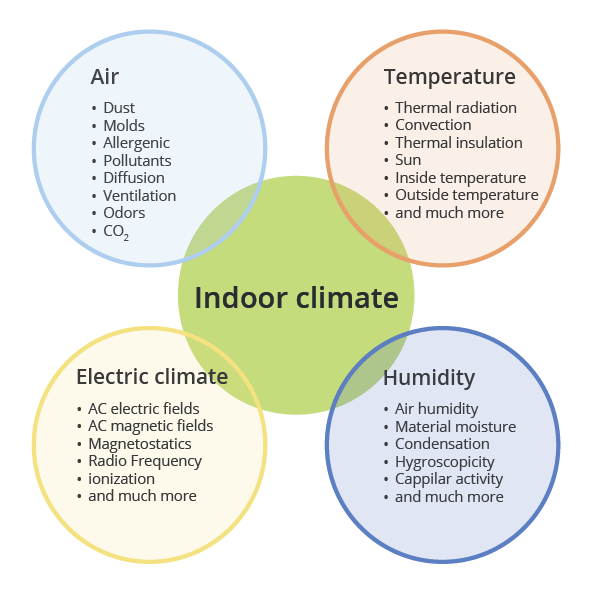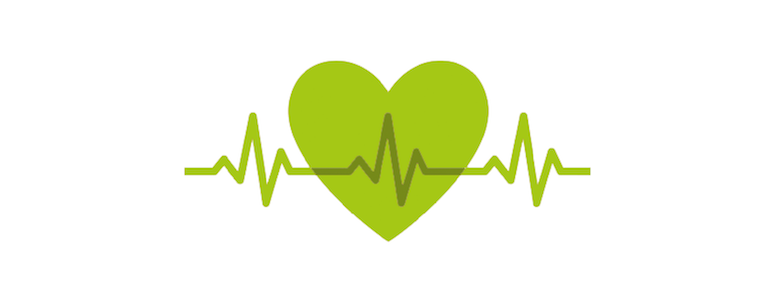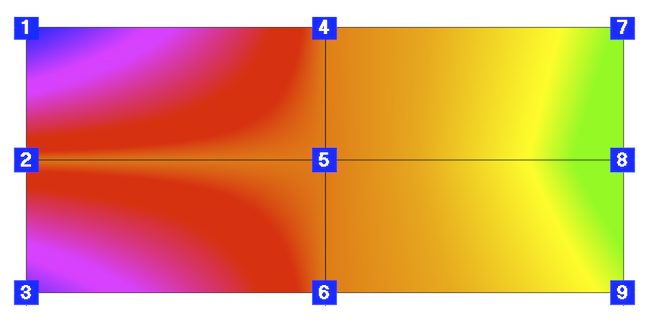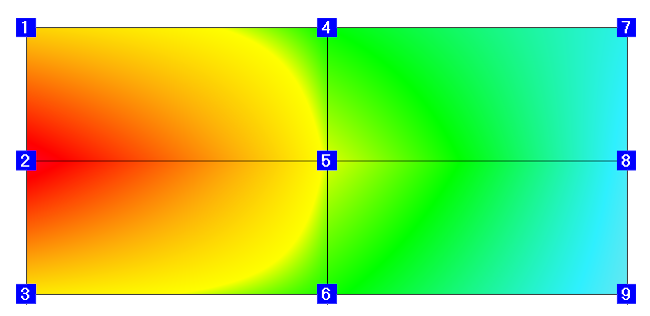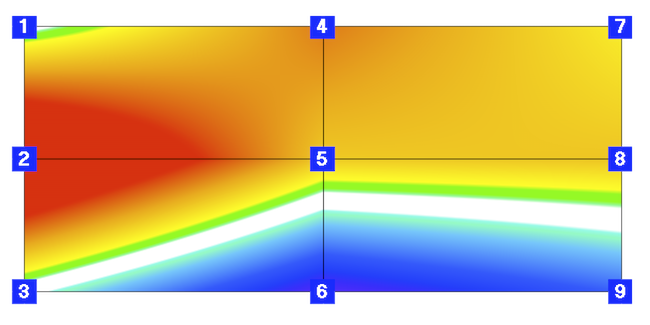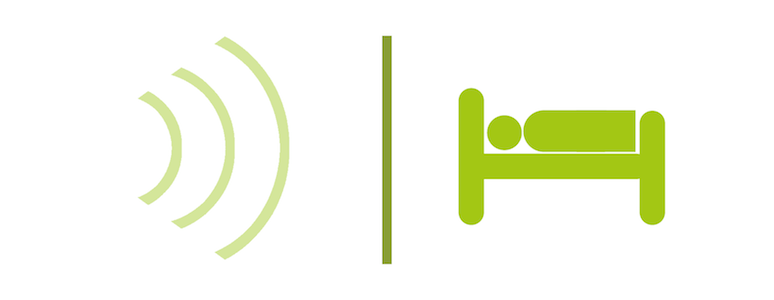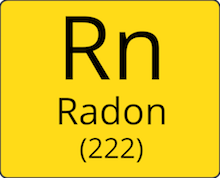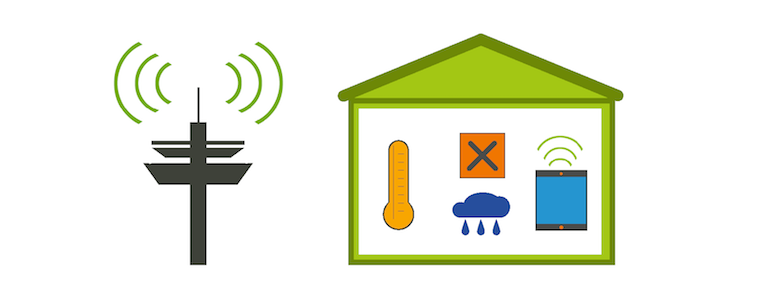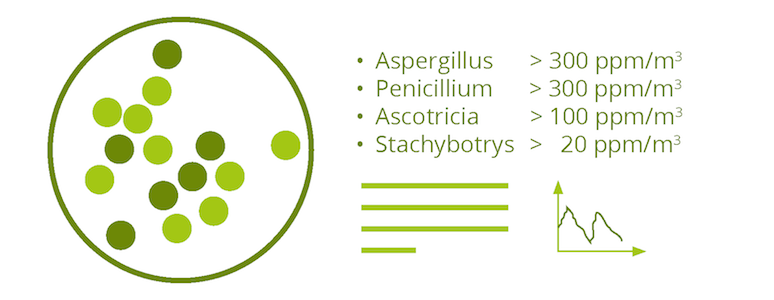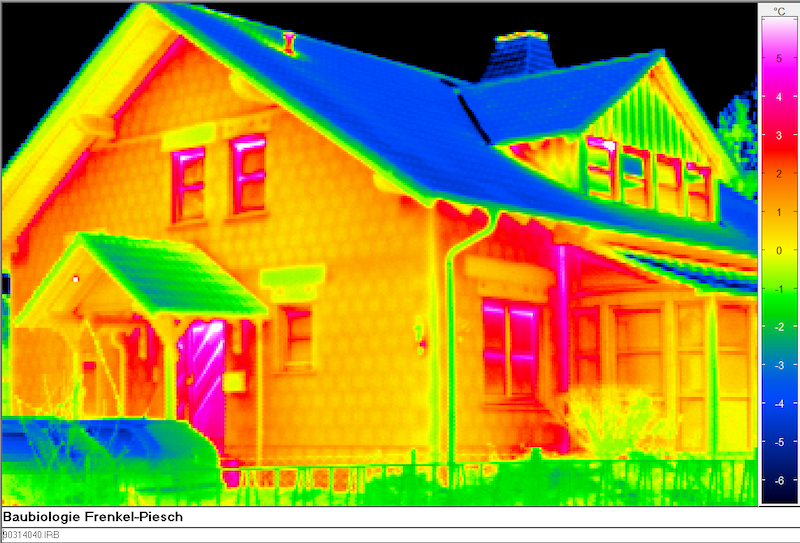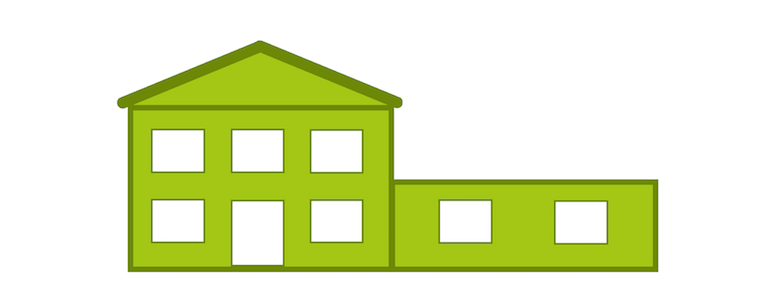Building Biology
Building Biology:
Building biology is the study of the holistic relationships between people and their living environment. (IBN)
Achieving the ideal state according to the 25 guidelines of building or renovation is often hardly realistic. Nevertheless, the effort should always be to realize every improvement in a sub-area according to building biology aspects as far as this is feasible.
Healthy, restful sleep can only happen in a healthy environment. Building biology excels at recognizing, analyzing, optimizing, if possible avoiding and advising on all the various environmental risk factors. It’s not the technically feasible maximum that’s at the heart of a building biology investigation, but it’s finding as many different illness-inducing factors as possible. After all, these can not only grow in their interaction with humans, but do so exponentially. Human health and well-being are what this is all about.
Indoor climate
Indoor climate is made up of a variety of factors. Air quality, room temperature or air humidity are just as important for a healthy indoor climate as the avoidance of electromagnetic fields as well as pollutant concentrations in the indoor air.
Indoor climate is an essential ingredient for comfortable, healthy living and supports the body’s recovery during the night’s rest, which is important for the formation of an intact immune system. Well-being and stamina, for example, depend on it.
Due to the multitude of influencing factors, a healthy indoor climate is often difficult to create or to maintain in a permanently healthy way. Internal as well as external environmental influences such as electromagnetic fields at low and high frequencies (electric smog), pollutants/noise, the number of people (CO2) in a room, building materials, materials of furnishings, type of electrical installations, etc. make it difficult to achieve a healthy indoor climate permanently. The following factors have an influence on indoor climate:
Air:
Composition of gases (e.g. oxygen, CO2), dust, fungi, bacteria, allergens, air movement, odor, etc.
Temperature:
Thermal radiation, thermal conduction, convection, surface temperature, heating/air conditioning, sun, etc.
Humidity:
Humidity, material moisture, condensation, hygroscopicity, vapor diffusion, etc.
Electrical climate:
AC electric fields, DC electric fields, AC magnetic fields, DC magnetic fields, high frequencies.
Electromagnetic Pollution
The term electric smog is a colloquial term and describes the sum of artificially generated electric, magnetic fields (EMF-NF) as well as electromagnetic field at high frequencies (EMF-HF), also called radiation. The more electrical devices as well as high-frequency radiating devices are present, the higher the “electric smog” load usually is.
The term electro-stress describes the negative biological or health effects or consequences that can result from human exposure to EMF-NF (AC / low frequency) fields as well as EMF-HF (high frequency) fields.
Examples: The 230V/50Hz power grid installed in buildings, light bulbs, transformers for halogen lights, kitchen appliances, electric floor heating, cordless phones (DECT), WLAN, smart phones, tablets, Bluetooth, wireless headsets, TV, HiFi equipment, smart home, smart meters, computers, office equipment, etc. Since many of the mentioned devices are often used at the same time, the EMF-HF/EMF-HF exposure and therefore the risk for electro-stress increases.
In nature there are no artificially generated electric, magnetic fields or as electromagnetic fields. Plants, animals and humans are adapted to a natural environment. Artificially generated electromagnetic fields can have a negative influence on this balance. The Institute for Building Biology + Sustainability (Institut für Baubiologie + Nachhaltigkeit IBN) and the European Academy of Environmental Medicine, EUROPAEM, recommends compliance with guideline values issued for this purpose: (IBN: Standard of Building Biology Measurement SBM-2015 / EUROPAEM: EUROPAEM EMF Guideline 2016 for the prevention, diagnosis and therapy of EMF-related complaints and diseases).
The International Agency for Research on Cancer (IARC), an institution of the World Health Organization (WHO), classifies electromagnetic fields, which arise for example during the use of WLAN or mobile radio, among group 2b as “potentially carcinogenic”. High frequency is suspected of causing oxidative cell stress and thereby negatively influencing cell regeneration during the night’s rest. Permanent oxidative cell stress or a lack of cell regeneration can result in a weakening of the immune system.
Electro-hypersensitivity (EHS)
Electro-hypersensitivity (EHS), like multiple chemical sensitivity (MCS), has been classified as a multi-system disease by the European Academy of Environmental Medicine (EUROPAEM). Increasing continuous EMF/HF exposure has resulted in an increase of electrosensitive people. Sensitivity does not first develop with EMF/HF exposure, symptoms occur when a limit of continuous stimulus or stress exposure has been reached for the body.
Hyper-(over-)sensitivity means that affected persons suffer physically from the effects of different partly environmental stresses and also show medically comprehensible changes. This can also result in a massive restriction of life, which can lead to everyday incapacity and even incapacity to work.
The so-called athermal effect of radio exposure has been known scientifically on an international scale for over a decade as a factor leading to increased free radical formation, and damage to mitochondria and the immune and nervous systems. EMF/HF exposure is generally considered a risk factor for diseases such as chronic fatigue, depression, ADD/ADHD, Alzheimer’s disease, infertility and cancer.
Evidenced by many international studies, environmental conditions such as increasing exposure of the population to radio waves, e.g., from cordless phones, cell phone transmitters, cell phones, GPRS/UMTS for laptops/notebooks, and wireless LAN (WLAN) but also to electric and magnetic fields emanating from wires, appliances, and equipment, are suspected to be causally involved (Blake Levitt and Lai 2010).
Electric AC Fields (low frequency)
Alternating electric fields come into being when voltage is present in a power line. In our home networks, this is 240V at 50Hz alternating voltage. The field is generated regardless of whether an appliance (lamp, radio, computer, etc.) is on or off. This means that whenever a wire is under AC voltage, an alternating electric field is formed around this wire and around all electronic devices connected to the mains, as long as a fuse is switched on. The alternating electric fields can be measured with appropriate instruments. The standard unit of electric field (E-field) strength is the volt per meter (V/m).
The measurement of electromagnetic alternating fields is carried out potential-free, i.e. the computer (laptop/notebook) used for the measurement is not connected to the mains and is operated exclusively by the device’s battery. Since the probe for measuring electromagnetic alternating fields reacts extremely sensitively to the environment, it is connected to the computer with a fiber optic cable in order to avoid interference for the measurement (potential-free measurement). The measurement of the alternating electric fields is isotropic, i.e. in three axes. Thus the sources of electromagnetic alternating fields can be localized optimally.
After determining the current state by way of measurement, recommendations for reduction and avoidance can be given. The recommendations are based on the guidelines of the EUROPAEM or the Building Biology Guidelines SBM-2015.
AC Magnetic Fields (low frequency)
The magnetic AC field is related to the alternating electric AC field. The difference is that it is only present when current flows or a consumer is switched on (e.g. light, radio, etc.).
Magnetic fields penetrate building materials and the human body almost unhindered and cannot be deflected or distorted as easily as alternating electric fields. Magnetic fields are therefore relatively easy to measure. Here, too, the measurement is made by means of an isotropic measurement (measurement in three axes).
In the case of magnetic AC fields, the so-called flux density is measured; this is specified in Tesla or in NanoTesla (nT). Since alternating magnetic fields are generated by flowing current, they also depend on how much current is flowing. For example, if many electrical appliances are switched on in the evening, more current flows. The alternating magnetic fields also increase as a result. The measurement of the alternating magnetic fields is isotropic, i.e. in three axes. This allows the sources to be optimally localized.
After determining the current state by way of measurement, recommendations for reduction and avoidance can be given. The recommendations are based on the guidelines of the EUROPAEM or the Building Biology Guidelines SBM-2015.
Static Magnetic Fields (Magnetostatics)
The largest constant magnetic field is our natural geomagnetic field (earth’s magnetic field) with a magnetic flux density of 20,000 – 60,000 nanotesla (nT), depending on one’s geographic location on the globe. In Europe, the magnetic flux density values are about 45,000 nT. The natural geomagnetic field is not only dependent on location, but is subject to normal fluctuations of about 10 to about 100 nT and is also influenced by geological faults, water veins and different grid formations.
Our body is adapted to a homogeneous, uniform terrestrial magnetic field. Artificially created magnetic fields (coils of a transformer, speakers, magnetized steel beams or steel reinforcements in the concrete of a building, radiators, metal constructions, battery-powered devices) influence the earth’s magnetic field. Strong technical magnetic DC fields are generated by tramways and subway railroads or by electric vehicles.
Electromagnetic Fields (high frequency)
Spectrum analysis
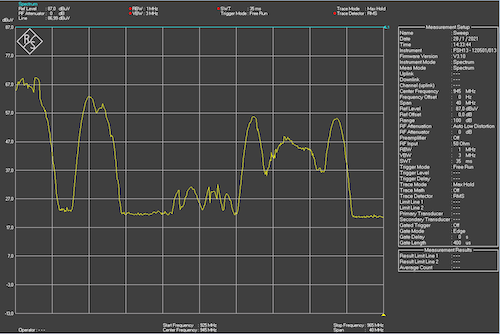
Broadband Measure
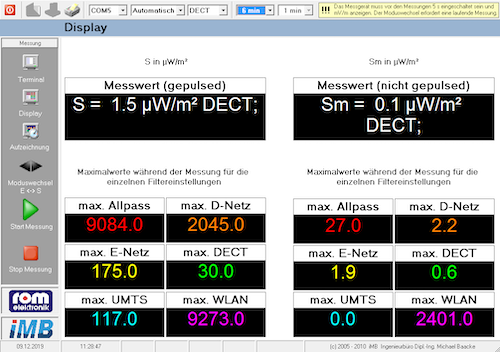
High frequency refers to frequency ranges above 300 kHz. Domestic sources of high frequency, such as WLAN or DECT telephones, can usually be localized well with an orienting broadband measurement. However, broadband measuring devices can only be used to display the sum of all frequencies present at the time of measurement, provided that these frequencies are also detected.
For the assessment of e.g. mobile radio exposure on building sites or in living or sleeping quarters, the orienting broadband measurement is no longer sufficient. Broadband measurements are reaching their limits, especially for the 4G/LTE and 5G mobile communications generations. The disadvantage of broadband measurement is that LTE signals operate predominantly with other radio services (GSM) in shared bands. However, broadband measurement devices cannot distinguish between these, and a mostly significant underestimation of an immission is the result. In order to be able to perform a frequency-selective measurement, so-called spectrum analysis is required. These measuring instruments are able to detect the respective frequency bands individually as well as the bandwidth.
Health effects of high-frequency radiation such as mobile communications or WLAN can manifest through symptoms such as chronic fatigue, insomnia, restlessness, nervousness or loss of performance. According to estimates, about five to nine percent of the population are already electrosensitive. The continuous exposure of human cells to EMF/HF is also called electro-stress. The RELEX study has demonstrated possible damage to human cells or DNA by electromagnetic fields. In 2021, a summary of relevant studies from the preceding 10 years on the subject of technical fields (electric, magnetic low-frequency fields and electromagnetic in the high frequency) confirmed oxidative cell stress in the majority.
Examples of radio services in Germany:
DAB+, DVB-T, Tetra, GSM 900, GSM 1800, LTE with frequencies around 700 / 800 / 900 MHz as well as around 2600 MHz , 5G with frequencies around 800 / 2000 / 3500 MHz, DECT telephony, Bluetooth, WLAN 2.4 GHz, WLAN 5 GHz, WLAN 6 GHz.
High Frequency Shielding
The shielding of high-frequency radiation (e.g. mobile communications, WLAN) can be achieved with a number of measures. It is useful when a reduction or avoidance of a radiation source is not possible or that source is not accessible. Examples: a wireless router in an adjacent apartment or a mobile radio transmitting station, etc. Before starting a shielding measure, a prior measurement of the local radiation situation is always necessary. Incorrectly applied shielding can lead to a worsening of the radiation exposure.
Shielding can be done in a variety of ways, e.g.
- Shielding of the electrical installation
- Installation of a mains disconnector (mains isolation switch)
- Curtains made of shielding fabrics
- Plasterboard with shielding properties for interior work
- Shielding clothing for traveling or on the road (e.g. airplane, train, car)
- Shielding paints for wall or ceiling surfaces
- Shielding fabrics in plaster facades
- Installation of windows with thermal insulation glazing
- and much more.
Radon Exposure
Radon is a naturally occurring radioactive noble gas, it is invisible, odorless as well as tasteless. Radon concentrations in the soil can vary greatly depending on geological conditions.
Radon enters buildings through leaks in the building components adjacent to the ground, where it can accumulate due to the low air exchange. 5% of all lung cancer deaths in Germany can be attributed to radon, according to the Federal Office for Radiation Protection. This makes radon the second most important risk factor for lung cancer after smoking.
The reference value from the Federal Office for Radiation Protection (BFS) for radon is 300 Bq/m3 (becquerels per cubic meter of indoor air) for existing buildings. For new buildings, a reference value of 200 Bq/m3 applies.
However, a risk of lung cancer may already exist at 100-200 Bq/m3. The recommendations of the BFS as well as the WHO are 100 Bq/m3. From a building biology point of view, a value of 30 Bq/m3 should not be exceeded if possible.
Risk Factors
So-called risk factors can have a significant impact on living environment or indoor climate and, if they affect people permanently, can cause health problems, allergies or chronic diseases. The risk factors include e.g.
- Molds
- Pollutants or residential toxins
- Electromagnetic fields and waves (electric smog)
- Indoor air quality
- Natural radon radioactivity concentrated in buildings
- Noise
Malaise, fatigue, lack of concentration, nervousness, restlessness, sleep disorders, allergies, chronic diseases can EHS (electro-hypersensitivity), MCS (multiple chemical sensitivity) can be caused by risk factors such as pollutants or residential toxins or electromagnetic fields and waves.
Molds
Molds require free water (condensation), sufficient temperature or organic substances as a breeding ground (furniture, wallpaper, etc.) to grow. The danger of mold growth exists starting at a room humidity of about 75% relative humidity.
Causes of mold infestation in buildings can be, for example:
- Missing or insufficient thermal insulation
- Thermal bridges
- Too little or improper heating
- Too high room humidity
- Insufficient air exchange
- Moisture storage of building materials
- Rising dampness in walls
- Building moisture in new buildings
- Water damage
Pollutants
In addition to environmental damage or damage to ecosystems, air pollutants also cause damage to human health. Air pollutants have a great influence on the quality of living in houses. Due to the holistic approach of building biology, analysis and detection of sources for the avoidance/reduction especially of pollutants belong to the core tasks.
For living spaces there are no designated limit values, so that as an aid the limit values of workplaces and outside air are consulted, in order to recommend from this according to the standard of the building biology measuring technique the adherence to guidelines. CO2 concentration is also of great importance in determining air quality.
Common pollutants and risk factors in buildings:
VVOC (very volatile organic compounds)
- Methanol
- Ethanol
- Dichloromethane
- Acetone
- and many more
VOC (volatile organic compounds)
- Formaldehyde
- Aldehydes
- Terpenes
- Isocyanates
- and many more
SVOC (low volatile organic compounds)
- Biocides (pesticides, insecticides, fungicides)
- Lindane
- Pentachlorophenol (PCP)
- Isocyanates
- and many more
MVOC (microbial organic compounds)
Outgassing of fungi and bacteria -> chlorine anisoles
Degradation products of chlorinated chemicals
Particles & fibers
- Asbestos
- Dust
- Fine dust
The number of MCS or CFS patients has been increasing in recent years. In patients describing the symptoms of CFS, the cause may also result from exposure to electromagnetic fields/waves, risking confusion of the cause with EHS (Electro-Magnetic-Hypersensitivity).
Building Thermography
Building thermography is an imaging process that uses an infrared thermal imaging camera to display the different temperature conditions in color.
The possibilities of building inspection by means of an infrared camera are versatile. In addition to the classic applications such as finding energy weaknesses in existing buildings, the thermal imaging camera can be used to locate leaks from water damage or to investigate leaks during an air tightness measurement of the building envelope.
The infrared thermal imaging camera used for this purpose has the proven high resolution scanner technology that enables high-quality and meaningful building thermography.
Building thermography is also very suitable for detecting leaks during air tightness measurements (blower door), e.g. for passive houses.
Moisture Investigation
Moisture tests in rooms on ceilings and walls. Basically, there are two types of water absorption:
Gaseous:
Too low surface temperatures can result in condensation on exterior walls as well as interior walls. However, moisture accumulation on wall surfaces should be avoided, as there is a risk of mold and the indoor climate is adversely affected.
Once the saturation moisture content in the room air is reached, condensation occurs, which is deposited on wall surfaces. A hygroscopic moisture load can simulate capillary rising damp. So-called summer condensation can also be the cause of moisture damage or mold growth in basements.
Liquid:
Water absorption from walls can be absorbed from the environment by the following factors:
- Driving rain
- Rising moisture due to capillary suction
- Soil moisture / seepage water
- Accumulated water / pressurized water
Moisture testing is always required in the evaluation for possible causes of mold infestation or cause of existing moisture.
Real Estate Investigation / Building Check
Purchasing a home of one’s own is, for many, one of the most significant events in life. Careful preparation is recommended before choosing the “new” home.
Don’t buy the proverbial “cat in the bag”, play it safe and have an expert accompany you on site visits. There are many things to look for in previously owned residential real estate to avoid an expensive surprise right from the get-go.
A building biology real estate investigation (building check) provides valuable support for a purchase decision. When buying an existing building, there are a number of things to consider, depending on its age and state of modernization:
- Building substance (solid or prefabricated construction)
- Building site
- Heating technology
- Damage to the building
- Moisture
- Mold
- Pollutants
- Influences from the environment ( high voltage lines, high frequency, etc.)
- Radon (naturally occurring radioactive noble gas concentrations in the soil)
Dilapidation Report / Documentation of the Condition of the Building
The purpose of a dilapitation report is to document the condition of a building before, for example, vibrations or changes are made to the terrain in the immediate vicinity as a result of a construction project, which may affect adjacent buildings. It can also be referred to as precautionary building condition documentation, in order to have proof of whether or not damage has already occurred to the documented building before the start of a construction project that has taken place in the vicinity.
Documentation of a building’s condition in conjunction with a planned building measure is a very suitable way to document the present condition, in order to be able to judge later causes of damages to buildings.






